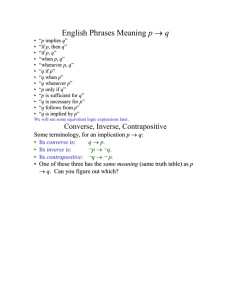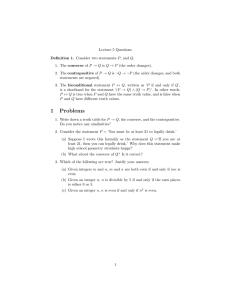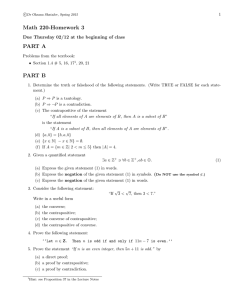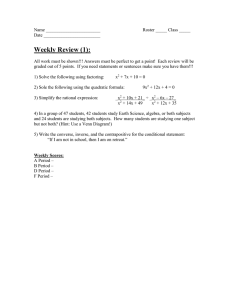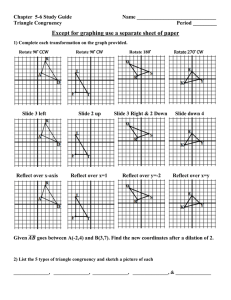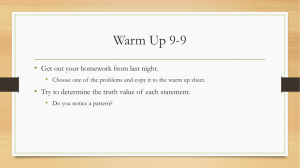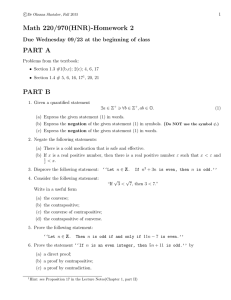Assignment1 Solutions Problem 1:Classify each of the following
advertisement
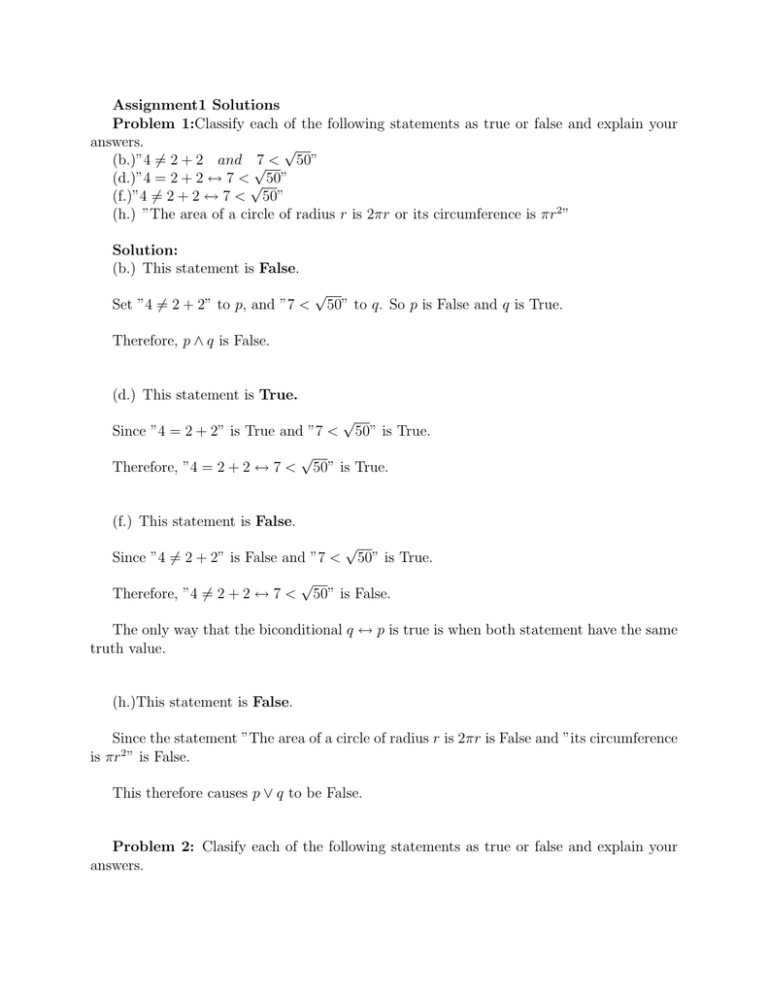
Assignment1 Solutions Problem 1:Classify each of the following statements as true or false and explain your answers. √ (b.)”4 6= 2 + 2 and √ 7 < 50” (d.)”4 = 2 + 2 ↔ 7 < √ 50” (f.)”4 6= 2 + 2 ↔ 7 < 50” (h.) ”The area of a circle of radius r is 2πr or its circumference is πr2 ” Solution: (b.) This statement is False. Set ”4 6= 2 + 2” to p, and ”7 < √ 50” to q. So p is False and q is True. Therefore, p ∧ q is False. (d.) This statement is True. Since ”4 = 2 + 2” is True and ”7 < Therefore, ”4 = 2 + 2 ↔ 7 < √ √ 50” is True. 50” is True. (f.) This statement is False. Since ”4 6= 2 + 2” is False and ”7 < Therefore, ”4 6= 2 + 2 ↔ 7 < √ √ 50” is True. 50” is False. The only way that the biconditional q ↔ p is true is when both statement have the same truth value. (h.)This statement is False. Since the statement ”The area of a circle of radius r is 2πr is False and ”its circumference is πr2 ” is False. This therefore causes p ∨ q to be False. Problem 2: Clasify each of the following statements as true or false and explain your answers. (b.) If a and b are integers with a − b > 0 and b − a > 0, then a = b. Solution: This statement is True. Since a and b are both integers then both a − b > 0 and b − a > 0 are false. Therefore, p → q is true, since p is false it does not matter whether q is true or false. Problem 3: Write down the negation of each of the following statements in clear and concise English. (b.) x is a real number and x2 + 1 = 0. (d.) Every integer is divisible by a prime. (f.) There exists a, b, and c such that (ab)c 6= a(bc). Solution: (b.) x is not a real number or x2 + 1 6= 0 (Use DeMorgan’s Law) (d.) There is an integer which is not divisble by a prime (f.) For all a, b, and c, (ab)c = a(bc). This was determined using ¬(∃xp(x)) ↔ ∀x¬p(x) Problem 4: Write down the converse and the contrapositive of each of the following implications. (d.) ab = 0 → a = 0 or b = 0. (f.) If 4BAC is a right triangle, then a2 = b2 + c2 . Solution: (d.)Converse: a = 0 or b = 0 → ab = 0 Contrapositive: a 6= 0 and b 6= 0 → ab 6= 0 (DeMorgan’s Law) (f.) Converse: If a2 = b2 + c2 , then 4BAC is a right triangle. Contrapositive: If a2 6= b2 + c2 , then 4BAC is not a right triangle. Problem 5: Rewrite each of the following statements using the quantifiers ”for all” and ”there exists” as appropriate. (b.) For real x, 2x is never negative. (f.) All positive real numbers have real square roots. Solution: (b.) There is no real x such that 2x is negative. (f.) For all positive real numbers its square root is real. Problem 6: Construct a truth table for each of the following compound statements. (c.) ¬(p ∧ (q ∨ p)) ↔ p. (e.) (p → (q → r)) → ((p ∧ q) ∨ r. Solution: p T (c.) T F F q T F T F q∨q T T T F p T T T (e.) T F F F F q T T F F T T F F r T F T F T F T F p ∧ (q ∨ p) ¬(p ∧ (q ∨ p)) ¬(p ∧ (q ∨ p)) ↔ p T F F T F F F T F F T F q→r T F T T T F T T p → (q → r) p ∧ q T T F T T F T F T F T F T F T F (p ∧ q) ∨ r T T T F T F T F (p → (p → r)) → ((p ∧ q) ∨ r) T T T F T F T F Problem 7: Determine the truth value for [p → (q ∧ (¬r))] ∨ [r ↔ ((¬s) ∨ q)] in the case where p, q, r and s are all false. Solution: p q F F r s F F ¬r T q ∧ (¬r) p → (q ∧ (¬r) ¬s F T T ¬s ∨ q T Therefore [p → (q ∧ (¬r))] ∨ [r ↔ ((¬s) ∨ q)] is True. Problem 8: (a.) Show that q → (p → q) ia a tautology. (b.) Show that [p ∧ q] ∧ [(¬p) ∨ (¬q)] is a contradiction. Solution: p T (a.) T F F q T F T F p→q T F T T q → (p → q) T T T T q → (p → q) is always True, which means we have a tautology. p T (b.) T F F q T F T F p∧q T F F F ¬p F F T T ¬q F T F T (¬p) ∨ (¬q) [p ∧ q] ∨ [(¬p) ∨ (¬q)] F F T F T F T F r ↔ ((¬s) ∨ q) F [p ∧ q] ∧ [(¬p) ∨ (¬q)] is always False, which means we have a contradiction. Problem 9: If p and q are statements, then the compound statement p Y q (often called the exclusive or) is defined to be true if and only if exactly one of p, q is true: that is either p is true or q is true, but not both p and q are true. (d.) Show that p Y q is logically equivalent to ¬(p ↔ q) Solution: p T T F F q T F T F pYq F T T F p↔q T F F T ¬(p ↔ q) F T T F p Y q and ¬(p ↔ q) have the same truth table. So therefore they are logically equivalent, that is p Y q ←→ ¬(p ↔ q).
